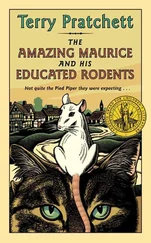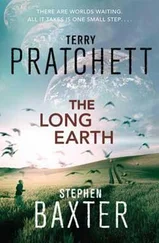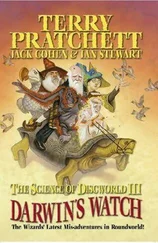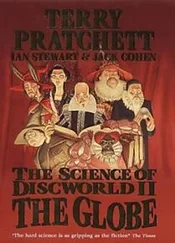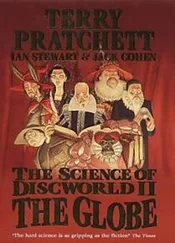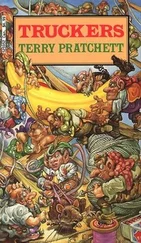Terry Pratchett - The Science of Discworld I
Здесь есть возможность читать онлайн «Terry Pratchett - The Science of Discworld I» весь текст электронной книги совершенно бесплатно (целиком полную версию без сокращений). В некоторых случаях можно слушать аудио, скачать через торрент в формате fb2 и присутствует краткое содержание. Жанр: Фантастика и фэнтези, на английском языке. Описание произведения, (предисловие) а так же отзывы посетителей доступны на портале библиотеки ЛибКат.
- Название:The Science of Discworld I
- Автор:
- Жанр:
- Год:неизвестен
- ISBN:нет данных
- Рейтинг книги:5 / 5. Голосов: 1
-
Избранное:Добавить в избранное
- Отзывы:
-
Ваша оценка:
- 100
- 1
- 2
- 3
- 4
- 5
The Science of Discworld I: краткое содержание, описание и аннотация
Предлагаем к чтению аннотацию, описание, краткое содержание или предисловие (зависит от того, что написал сам автор книги «The Science of Discworld I»). Если вы не нашли необходимую информацию о книге — напишите в комментариях, мы постараемся отыскать её.
The Science of Discworld I — читать онлайн бесплатно полную книгу (весь текст) целиком
Ниже представлен текст книги, разбитый по страницам. Система сохранения места последней прочитанной страницы, позволяет с удобством читать онлайн бесплатно книгу «The Science of Discworld I», без необходимости каждый раз заново искать на чём Вы остановились. Поставьте закладку, и сможете в любой момент перейти на страницу, на которой закончили чтение.
Интервал:
Закладка:
In the 1960s, however, Wegener's ideas became orthodox and the theory of 'continental drift' became established, though the ancient supercontinent was renamed Gondwanaland because it differed in some ways from Wegener's conception of Pangea. At a meeting of leading geologists, a Ponder Stibbons-like young man named Edward Bullard and two colleagues enlisted the aid of a new piece of kit called a computer They instructed the machine to find the best fit between Africa and South America, and North America, and Europe, allowing for a bit of breakage but not too much. Instead of using today's coastline, which was never a very sensible idea but made it possible to claim that the fit wasn't actually that good, they used the contour corresponding to a depth of 3200 feet (1000 m) underwater, whose shape is less likely to have been changed by erosion. The fit was good, and the geology across the join matched amazingly well. And even though the people at the conference came out just as divided in their opinions as they'd been when they went in, somehow continental drift had become the consensus.
Today we have much more evidence, and a fair idea of the mechanism. Down the middle of the Atlantic Ocean, and elsewhere in other oceans, there runs a ridge, roughly north-south and about midway between South America and Africa. Volcanic material is welling up along that ridge, and spreading sideways. It's been spreading for 200 million years, and it's still doing it today: we can even send deep-sea submarines down there to watch. It's not spreading at speeds humans can see, America moves about three-quarters of an inch (2 cm) further away from Africa every year, about the same rate that your fingernails grow, but today's instruments can easily measure such a change.
The most striking evidence for continental drift is magnetic: the rocks on either side bear a curious pattern of magnetic stripes, reversing polarity from north to south and back again, and that pattern is symmetric on either side of the ridge, making it clear that the stripes were frozen in place as the rocks cooled in the Earth's magnetic field. Whenever the Earth's dynamo flipped polarity, as it does from time to time, the rock immediately adjacent to the ridge-line, on either side, got the same new polarity. As the rocks then spread apart, they took the same patterns of stripes with them.
The surface of the Earth is not a solid sphere. Instead, the continents and the ocean-beds float on top of large, essentially solid plates, and those plates can be driven apart by upwelling magma. (Oh, but mostly by convection in the mantle. Jeffreys didn't know what we now know about how the mantle moves.) There are about a dozen plates, ranging from 600 miles (1000 km) across to 6000 miles (10,000 km), and they twist and turn. Where plate boundaries rub against each other, sticking and slipping and sticking and slipping, you get a lot of earthquakes and volcanoes. Especially along the 'Pacific rim', the edge of the Pacific Ocean up along the west coast of Chile, central America, the USA, along down past Japan, and back round New Zealand, which is all the edge of a single gigantic plate. Where plate boundaries collide you get mountain ranges: one plate burrows under the other, lifting it up and crushing and folding its edges. India was once not part of the main Asian continent at all, but came crashing into it, creating the world's highest mountain range, the Himalayas. India hasn't fully stopped even now, and the Himalayas are still being pushed up by the force of the impact.
17. SUIT OF SPELLS
A FIGURE WAS FROGMARCHED through the early-morning corridors, surrounded by the senior wizards. It wore a long white nightshirt, and a nightcap with the word 'Wizzard' embroidered, inexpertly, on it. It was Unseen University's least qualified but most well-travelled member, usually away from something. And it was in trouble.
'This won't hurt a bit,' said the Senior Wrangler.
'It's right up your street,' said the Lecturer in Recent Runes.
'It's on a log and in your face,' explained the Dean.
'That isn't what HEX said, is it?' said the Senior Wrangler, as the sleepy figure was hustled around a corner.
'Very similar, but what HEX said made less sense,' said the Dean.
They hurried across the lawn and barged through the doors in the High Energy Magic Building.
Mustrum Ridcully finished filling his pipe, and struck a match on the dome of the Project. Then he turned, and smiled.
'Ah, Rincewind,' he said. 'Good of you to come.'
'I was dragged, sir.'
'Well done. And I have good news. I intend to appoint you Egregious Professor of Cruel and Unusual Geography. The post is vacant.'
Rincewind looked past him. On the far side of the room some of the junior wizards were working in a haze of magic that made it hard to see exactly what it was they were working on, but it looked almost like ... some sort of skeleton.
'Oh,' he said. 'Er ... but I'm very happy as assistant librarian. I'm getting really good at peeling the bananas.'
'But the new post offers you room, board and all your laundry done,' said the Archchancellor.
'But I get that already, sir.'
Ridcully drew leisurely on his pipe and blew out a cloud of blue smoke.
'Up until now,' he said.
'Oh. I see. And you're about to send me somewhere really dangerous, yes?'
Ridcully beamed. 'How did you guess?'
'It wasn't a guess.'
Fortunately the Dean had been forewarned and had grabbed the back of Rincewind's nightshirt, and so he was ready. The wizard's bedroom slippers skidded uselessly on the tiles as he tried to make for the door.
'It's best to let him run for a little while,', said the Senior Wrangler. 'It's a nervous reaction.'
'And the best thing is,' said Ridcully, to Rincewind's back, 'that although we are sending you to a place of immense danger where no living thing could possibly survive, you will not, in so many words, actually be there. Won't that be nice?'
Rincewind hesitated.
'How many words?'
'It'll be like being in a ... story,' said the Archchancellor. 'Or ... or a dream, as far as I can understand it. Mister Stibbons! Come and explain!'
'Oh, hello, Rincewind,' said Ponder, stepping out of the mist and wiping his hands on a rag. 'Twelve spells HEX has amalgamated for this! It's an amazing piece of thaumaturgical engineering! Do come and see!'
There are creatures which have evolved to live in coral reefs and simply could not survive in the rough, tooth-filled wastes of the open sea. They continue to exist by lurking among the dangerous tentacles of the sea anemone or around the lips of the giant clam and other perilous crevices shunned by all sensible fish.
A university is very much like a coral reef. It provides calm waters and food particles for delicate yet marvellously constructed organisms that could not possibly survive in the pounding surf of reality, where people ask questions like 'Is what you do of any use?' and other nonsense.
In fact Rincewind in his association with UU had survived dangers that would have stripped a hero to the bone, but he nevertheless believed, despite all the evidence to the contrary, that he was safe in the university. He would do anything to stay on the roll.
At the moment this involved looking at some sort of skeletal armour made out of smoke while Ponder Stibbons gabbled incomprehensible words in his ear. As far as he could understand it, the thing put all your senses somewhere else when you stayed here. So far, that sounded quite acceptable, since it had always seemed to Rincewind that if you had to go a long way away it'd be nice to stay at home while you did it, but people seemed a little unclear about where pain fitted in.
Читать дальшеИнтервал:
Закладка:
Похожие книги на «The Science of Discworld I»
Представляем Вашему вниманию похожие книги на «The Science of Discworld I» списком для выбора. Мы отобрали схожую по названию и смыслу литературу в надежде предоставить читателям больше вариантов отыскать новые, интересные, ещё непрочитанные произведения.
Обсуждение, отзывы о книге «The Science of Discworld I» и просто собственные мнения читателей. Оставьте ваши комментарии, напишите, что Вы думаете о произведении, его смысле или главных героях. Укажите что конкретно понравилось, а что нет, и почему Вы так считаете.

